Comparative Analysis of Criticisms on Edgar Allan Poe's The Raven
VerifiedAdded on 2022/08/16
|7
|1827
|13
Essay
AI Summary
This essay offers a comparative analysis of Edgar Allan Poe's "The Raven", examining critical interpretations by William Freedman and John Ingram. The essay explores the poem's themes, symbolism, and structure, highlighting the significance of the raven as a central symbol of grief, death, and the speaker's descent into madness. It delves into Freedman's analysis of the poem's structure, symbolism, and the concept of obscurity, while also considering Ingram's perspective on the poem's reception, potential influences, and the use of borrowed elements. The essay explores the critical debates surrounding the poem, including the influence of precursors, the use of language, and the poem's enduring popularity and impact on literature. The analysis also covers the psychological and metaphysical implications of the raven and Lenore, and the themes of name, namelessness, and the speaker's quest for solace. The essay concludes by emphasizing the richness of symbolism and the enduring legacy of Poe's poem.
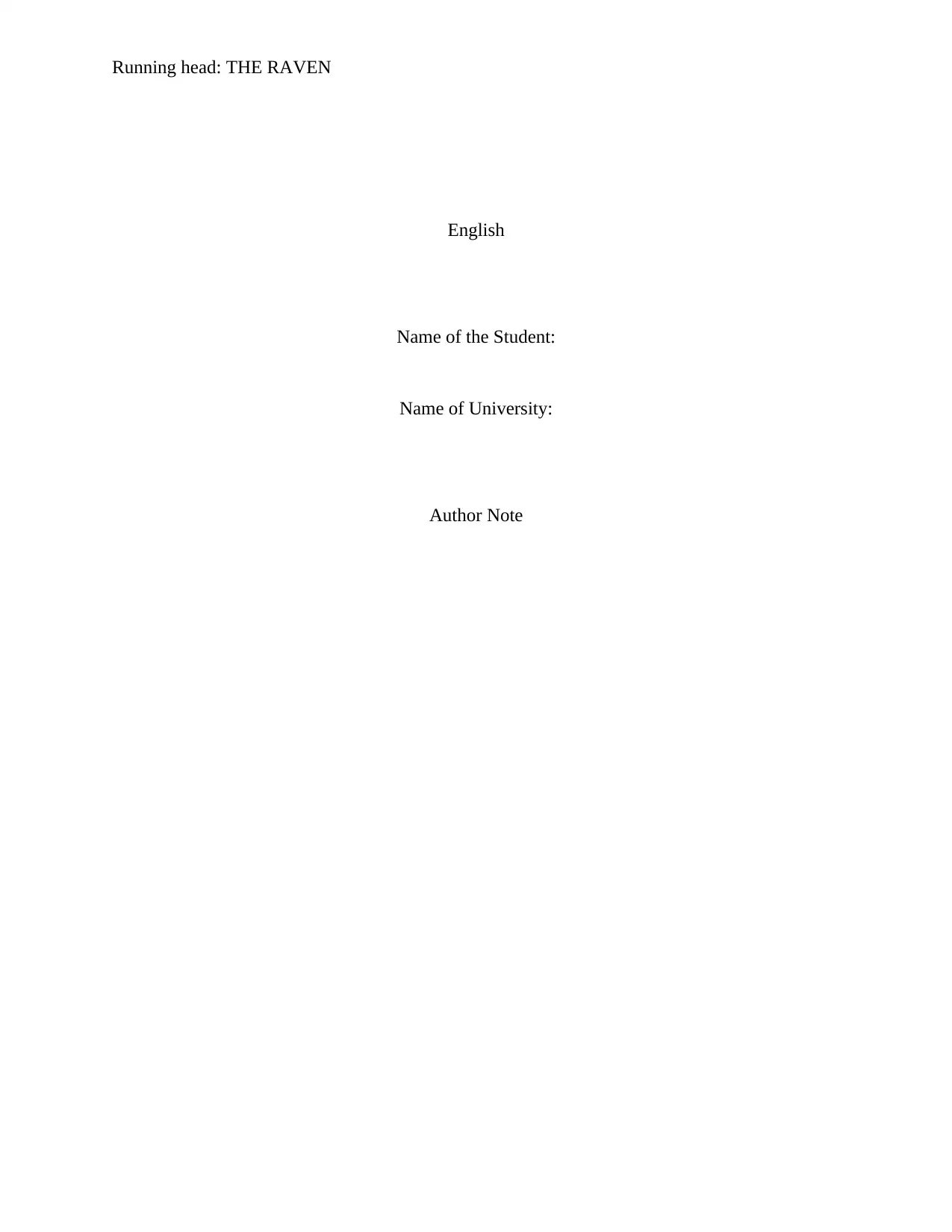
Running head: THE RAVEN
English
Name of the Student:
Name of University:
Author Note
English
Name of the Student:
Name of University:
Author Note
Paraphrase This Document
Need a fresh take? Get an instant paraphrase of this document with our AI Paraphraser
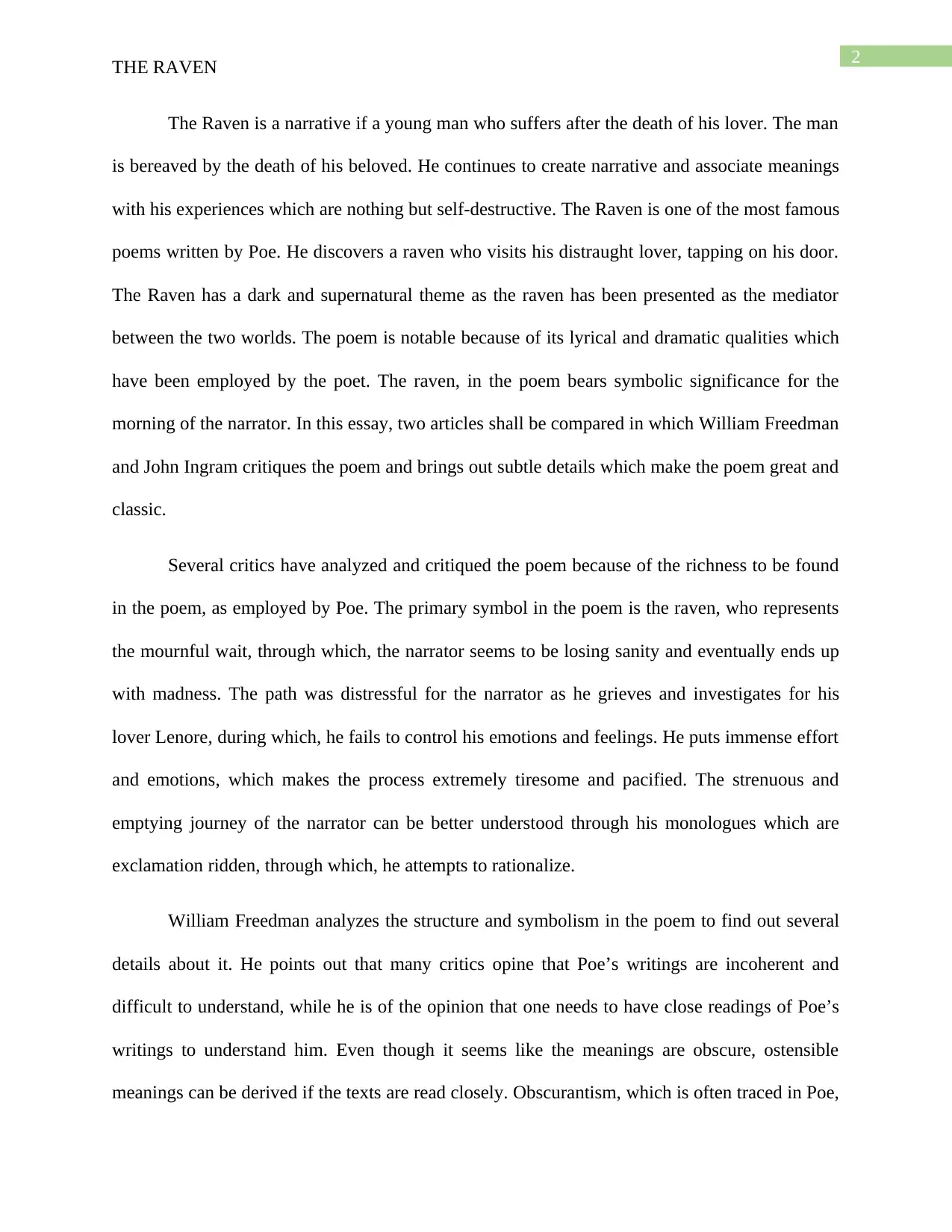
2
THE RAVEN
The Raven is a narrative if a young man who suffers after the death of his lover. The man
is bereaved by the death of his beloved. He continues to create narrative and associate meanings
with his experiences which are nothing but self-destructive. The Raven is one of the most famous
poems written by Poe. He discovers a raven who visits his distraught lover, tapping on his door.
The Raven has a dark and supernatural theme as the raven has been presented as the mediator
between the two worlds. The poem is notable because of its lyrical and dramatic qualities which
have been employed by the poet. The raven, in the poem bears symbolic significance for the
morning of the narrator. In this essay, two articles shall be compared in which William Freedman
and John Ingram critiques the poem and brings out subtle details which make the poem great and
classic.
Several critics have analyzed and critiqued the poem because of the richness to be found
in the poem, as employed by Poe. The primary symbol in the poem is the raven, who represents
the mournful wait, through which, the narrator seems to be losing sanity and eventually ends up
with madness. The path was distressful for the narrator as he grieves and investigates for his
lover Lenore, during which, he fails to control his emotions and feelings. He puts immense effort
and emotions, which makes the process extremely tiresome and pacified. The strenuous and
emptying journey of the narrator can be better understood through his monologues which are
exclamation ridden, through which, he attempts to rationalize.
William Freedman analyzes the structure and symbolism in the poem to find out several
details about it. He points out that many critics opine that Poe’s writings are incoherent and
difficult to understand, while he is of the opinion that one needs to have close readings of Poe’s
writings to understand him. Even though it seems like the meanings are obscure, ostensible
meanings can be derived if the texts are read closely. Obscurantism, which is often traced in Poe,
THE RAVEN
The Raven is a narrative if a young man who suffers after the death of his lover. The man
is bereaved by the death of his beloved. He continues to create narrative and associate meanings
with his experiences which are nothing but self-destructive. The Raven is one of the most famous
poems written by Poe. He discovers a raven who visits his distraught lover, tapping on his door.
The Raven has a dark and supernatural theme as the raven has been presented as the mediator
between the two worlds. The poem is notable because of its lyrical and dramatic qualities which
have been employed by the poet. The raven, in the poem bears symbolic significance for the
morning of the narrator. In this essay, two articles shall be compared in which William Freedman
and John Ingram critiques the poem and brings out subtle details which make the poem great and
classic.
Several critics have analyzed and critiqued the poem because of the richness to be found
in the poem, as employed by Poe. The primary symbol in the poem is the raven, who represents
the mournful wait, through which, the narrator seems to be losing sanity and eventually ends up
with madness. The path was distressful for the narrator as he grieves and investigates for his
lover Lenore, during which, he fails to control his emotions and feelings. He puts immense effort
and emotions, which makes the process extremely tiresome and pacified. The strenuous and
emptying journey of the narrator can be better understood through his monologues which are
exclamation ridden, through which, he attempts to rationalize.
William Freedman analyzes the structure and symbolism in the poem to find out several
details about it. He points out that many critics opine that Poe’s writings are incoherent and
difficult to understand, while he is of the opinion that one needs to have close readings of Poe’s
writings to understand him. Even though it seems like the meanings are obscure, ostensible
meanings can be derived if the texts are read closely. Obscurantism, which is often traced in Poe,
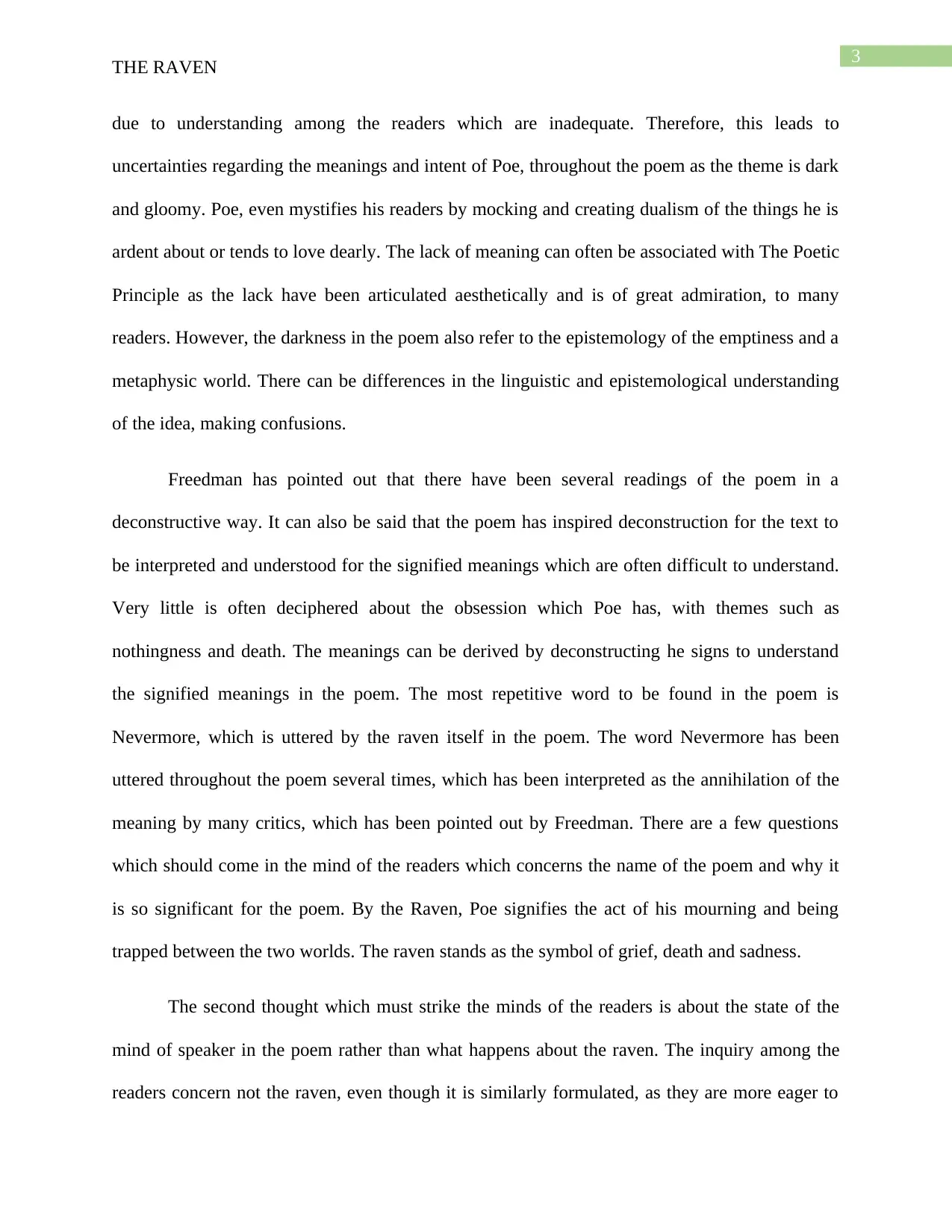
3
THE RAVEN
due to understanding among the readers which are inadequate. Therefore, this leads to
uncertainties regarding the meanings and intent of Poe, throughout the poem as the theme is dark
and gloomy. Poe, even mystifies his readers by mocking and creating dualism of the things he is
ardent about or tends to love dearly. The lack of meaning can often be associated with The Poetic
Principle as the lack have been articulated aesthetically and is of great admiration, to many
readers. However, the darkness in the poem also refer to the epistemology of the emptiness and a
metaphysic world. There can be differences in the linguistic and epistemological understanding
of the idea, making confusions.
Freedman has pointed out that there have been several readings of the poem in a
deconstructive way. It can also be said that the poem has inspired deconstruction for the text to
be interpreted and understood for the signified meanings which are often difficult to understand.
Very little is often deciphered about the obsession which Poe has, with themes such as
nothingness and death. The meanings can be derived by deconstructing he signs to understand
the signified meanings in the poem. The most repetitive word to be found in the poem is
Nevermore, which is uttered by the raven itself in the poem. The word Nevermore has been
uttered throughout the poem several times, which has been interpreted as the annihilation of the
meaning by many critics, which has been pointed out by Freedman. There are a few questions
which should come in the mind of the readers which concerns the name of the poem and why it
is so significant for the poem. By the Raven, Poe signifies the act of his mourning and being
trapped between the two worlds. The raven stands as the symbol of grief, death and sadness.
The second thought which must strike the minds of the readers is about the state of the
mind of speaker in the poem rather than what happens about the raven. The inquiry among the
readers concern not the raven, even though it is similarly formulated, as they are more eager to
THE RAVEN
due to understanding among the readers which are inadequate. Therefore, this leads to
uncertainties regarding the meanings and intent of Poe, throughout the poem as the theme is dark
and gloomy. Poe, even mystifies his readers by mocking and creating dualism of the things he is
ardent about or tends to love dearly. The lack of meaning can often be associated with The Poetic
Principle as the lack have been articulated aesthetically and is of great admiration, to many
readers. However, the darkness in the poem also refer to the epistemology of the emptiness and a
metaphysic world. There can be differences in the linguistic and epistemological understanding
of the idea, making confusions.
Freedman has pointed out that there have been several readings of the poem in a
deconstructive way. It can also be said that the poem has inspired deconstruction for the text to
be interpreted and understood for the signified meanings which are often difficult to understand.
Very little is often deciphered about the obsession which Poe has, with themes such as
nothingness and death. The meanings can be derived by deconstructing he signs to understand
the signified meanings in the poem. The most repetitive word to be found in the poem is
Nevermore, which is uttered by the raven itself in the poem. The word Nevermore has been
uttered throughout the poem several times, which has been interpreted as the annihilation of the
meaning by many critics, which has been pointed out by Freedman. There are a few questions
which should come in the mind of the readers which concerns the name of the poem and why it
is so significant for the poem. By the Raven, Poe signifies the act of his mourning and being
trapped between the two worlds. The raven stands as the symbol of grief, death and sadness.
The second thought which must strike the minds of the readers is about the state of the
mind of speaker in the poem rather than what happens about the raven. The inquiry among the
readers concern not the raven, even though it is similarly formulated, as they are more eager to
⊘ This is a preview!⊘
Do you want full access?
Subscribe today to unlock all pages.

Trusted by 1+ million students worldwide
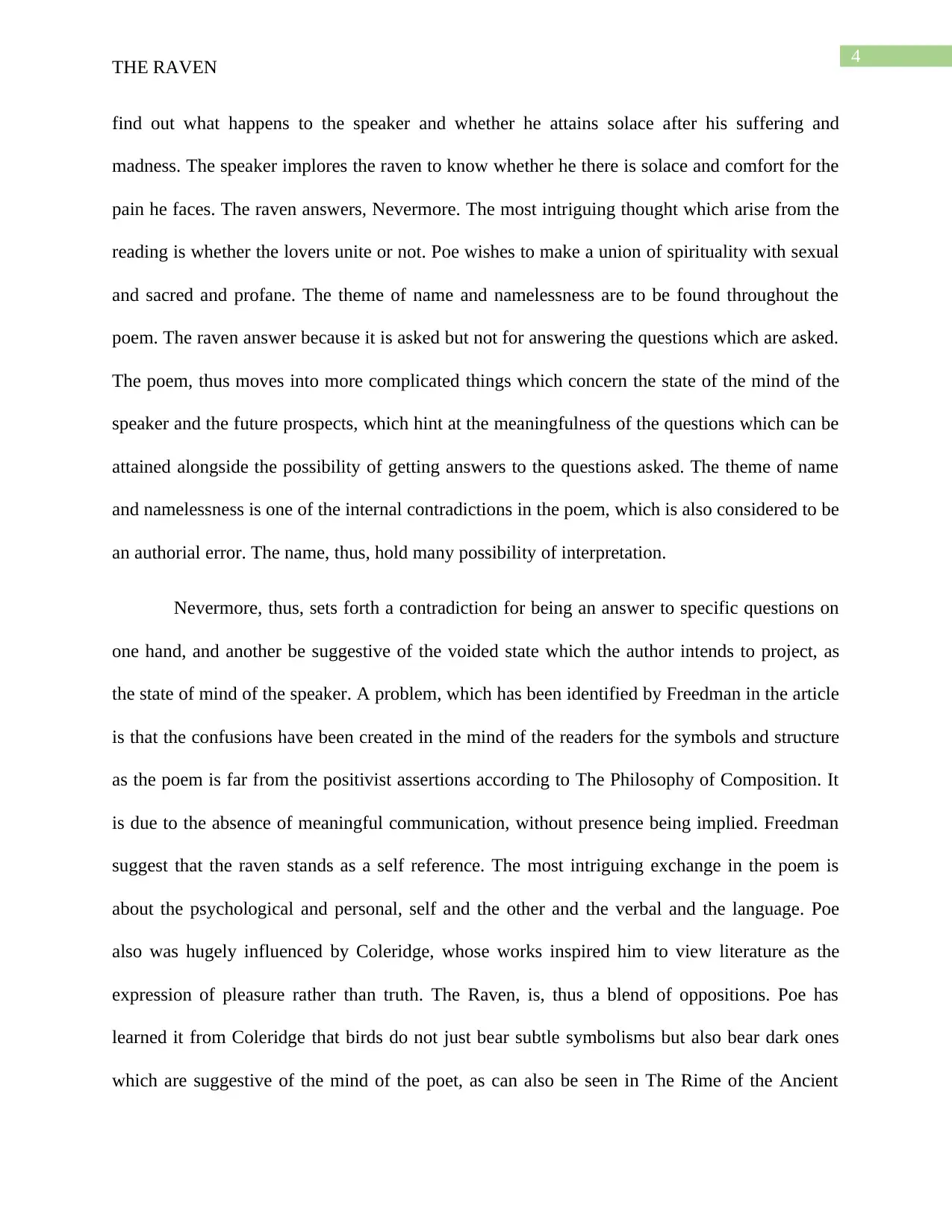
4
THE RAVEN
find out what happens to the speaker and whether he attains solace after his suffering and
madness. The speaker implores the raven to know whether he there is solace and comfort for the
pain he faces. The raven answers, Nevermore. The most intriguing thought which arise from the
reading is whether the lovers unite or not. Poe wishes to make a union of spirituality with sexual
and sacred and profane. The theme of name and namelessness are to be found throughout the
poem. The raven answer because it is asked but not for answering the questions which are asked.
The poem, thus moves into more complicated things which concern the state of the mind of the
speaker and the future prospects, which hint at the meaningfulness of the questions which can be
attained alongside the possibility of getting answers to the questions asked. The theme of name
and namelessness is one of the internal contradictions in the poem, which is also considered to be
an authorial error. The name, thus, hold many possibility of interpretation.
Nevermore, thus, sets forth a contradiction for being an answer to specific questions on
one hand, and another be suggestive of the voided state which the author intends to project, as
the state of mind of the speaker. A problem, which has been identified by Freedman in the article
is that the confusions have been created in the mind of the readers for the symbols and structure
as the poem is far from the positivist assertions according to The Philosophy of Composition. It
is due to the absence of meaningful communication, without presence being implied. Freedman
suggest that the raven stands as a self reference. The most intriguing exchange in the poem is
about the psychological and personal, self and the other and the verbal and the language. Poe
also was hugely influenced by Coleridge, whose works inspired him to view literature as the
expression of pleasure rather than truth. The Raven, is, thus a blend of oppositions. Poe has
learned it from Coleridge that birds do not just bear subtle symbolisms but also bear dark ones
which are suggestive of the mind of the poet, as can also be seen in The Rime of the Ancient
THE RAVEN
find out what happens to the speaker and whether he attains solace after his suffering and
madness. The speaker implores the raven to know whether he there is solace and comfort for the
pain he faces. The raven answers, Nevermore. The most intriguing thought which arise from the
reading is whether the lovers unite or not. Poe wishes to make a union of spirituality with sexual
and sacred and profane. The theme of name and namelessness are to be found throughout the
poem. The raven answer because it is asked but not for answering the questions which are asked.
The poem, thus moves into more complicated things which concern the state of the mind of the
speaker and the future prospects, which hint at the meaningfulness of the questions which can be
attained alongside the possibility of getting answers to the questions asked. The theme of name
and namelessness is one of the internal contradictions in the poem, which is also considered to be
an authorial error. The name, thus, hold many possibility of interpretation.
Nevermore, thus, sets forth a contradiction for being an answer to specific questions on
one hand, and another be suggestive of the voided state which the author intends to project, as
the state of mind of the speaker. A problem, which has been identified by Freedman in the article
is that the confusions have been created in the mind of the readers for the symbols and structure
as the poem is far from the positivist assertions according to The Philosophy of Composition. It
is due to the absence of meaningful communication, without presence being implied. Freedman
suggest that the raven stands as a self reference. The most intriguing exchange in the poem is
about the psychological and personal, self and the other and the verbal and the language. Poe
also was hugely influenced by Coleridge, whose works inspired him to view literature as the
expression of pleasure rather than truth. The Raven, is, thus a blend of oppositions. Poe has
learned it from Coleridge that birds do not just bear subtle symbolisms but also bear dark ones
which are suggestive of the mind of the poet, as can also be seen in The Rime of the Ancient
Paraphrase This Document
Need a fresh take? Get an instant paraphrase of this document with our AI Paraphraser
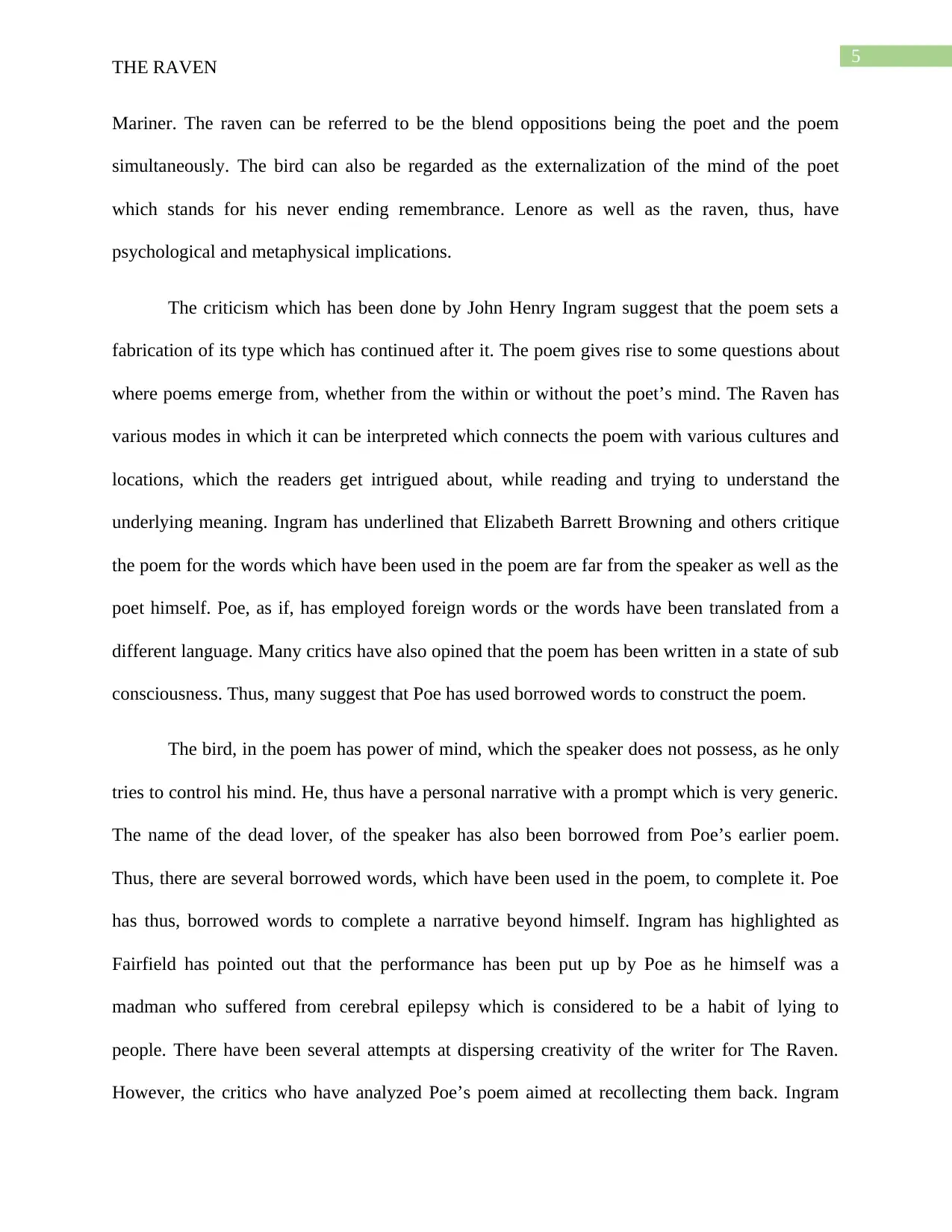
5
THE RAVEN
Mariner. The raven can be referred to be the blend oppositions being the poet and the poem
simultaneously. The bird can also be regarded as the externalization of the mind of the poet
which stands for his never ending remembrance. Lenore as well as the raven, thus, have
psychological and metaphysical implications.
The criticism which has been done by John Henry Ingram suggest that the poem sets a
fabrication of its type which has continued after it. The poem gives rise to some questions about
where poems emerge from, whether from the within or without the poet’s mind. The Raven has
various modes in which it can be interpreted which connects the poem with various cultures and
locations, which the readers get intrigued about, while reading and trying to understand the
underlying meaning. Ingram has underlined that Elizabeth Barrett Browning and others critique
the poem for the words which have been used in the poem are far from the speaker as well as the
poet himself. Poe, as if, has employed foreign words or the words have been translated from a
different language. Many critics have also opined that the poem has been written in a state of sub
consciousness. Thus, many suggest that Poe has used borrowed words to construct the poem.
The bird, in the poem has power of mind, which the speaker does not possess, as he only
tries to control his mind. He, thus have a personal narrative with a prompt which is very generic.
The name of the dead lover, of the speaker has also been borrowed from Poe’s earlier poem.
Thus, there are several borrowed words, which have been used in the poem, to complete it. Poe
has thus, borrowed words to complete a narrative beyond himself. Ingram has highlighted as
Fairfield has pointed out that the performance has been put up by Poe as he himself was a
madman who suffered from cerebral epilepsy which is considered to be a habit of lying to
people. There have been several attempts at dispersing creativity of the writer for The Raven.
However, the critics who have analyzed Poe’s poem aimed at recollecting them back. Ingram
THE RAVEN
Mariner. The raven can be referred to be the blend oppositions being the poet and the poem
simultaneously. The bird can also be regarded as the externalization of the mind of the poet
which stands for his never ending remembrance. Lenore as well as the raven, thus, have
psychological and metaphysical implications.
The criticism which has been done by John Henry Ingram suggest that the poem sets a
fabrication of its type which has continued after it. The poem gives rise to some questions about
where poems emerge from, whether from the within or without the poet’s mind. The Raven has
various modes in which it can be interpreted which connects the poem with various cultures and
locations, which the readers get intrigued about, while reading and trying to understand the
underlying meaning. Ingram has underlined that Elizabeth Barrett Browning and others critique
the poem for the words which have been used in the poem are far from the speaker as well as the
poet himself. Poe, as if, has employed foreign words or the words have been translated from a
different language. Many critics have also opined that the poem has been written in a state of sub
consciousness. Thus, many suggest that Poe has used borrowed words to construct the poem.
The bird, in the poem has power of mind, which the speaker does not possess, as he only
tries to control his mind. He, thus have a personal narrative with a prompt which is very generic.
The name of the dead lover, of the speaker has also been borrowed from Poe’s earlier poem.
Thus, there are several borrowed words, which have been used in the poem, to complete it. Poe
has thus, borrowed words to complete a narrative beyond himself. Ingram has highlighted as
Fairfield has pointed out that the performance has been put up by Poe as he himself was a
madman who suffered from cerebral epilepsy which is considered to be a habit of lying to
people. There have been several attempts at dispersing creativity of the writer for The Raven.
However, the critics who have analyzed Poe’s poem aimed at recollecting them back. Ingram
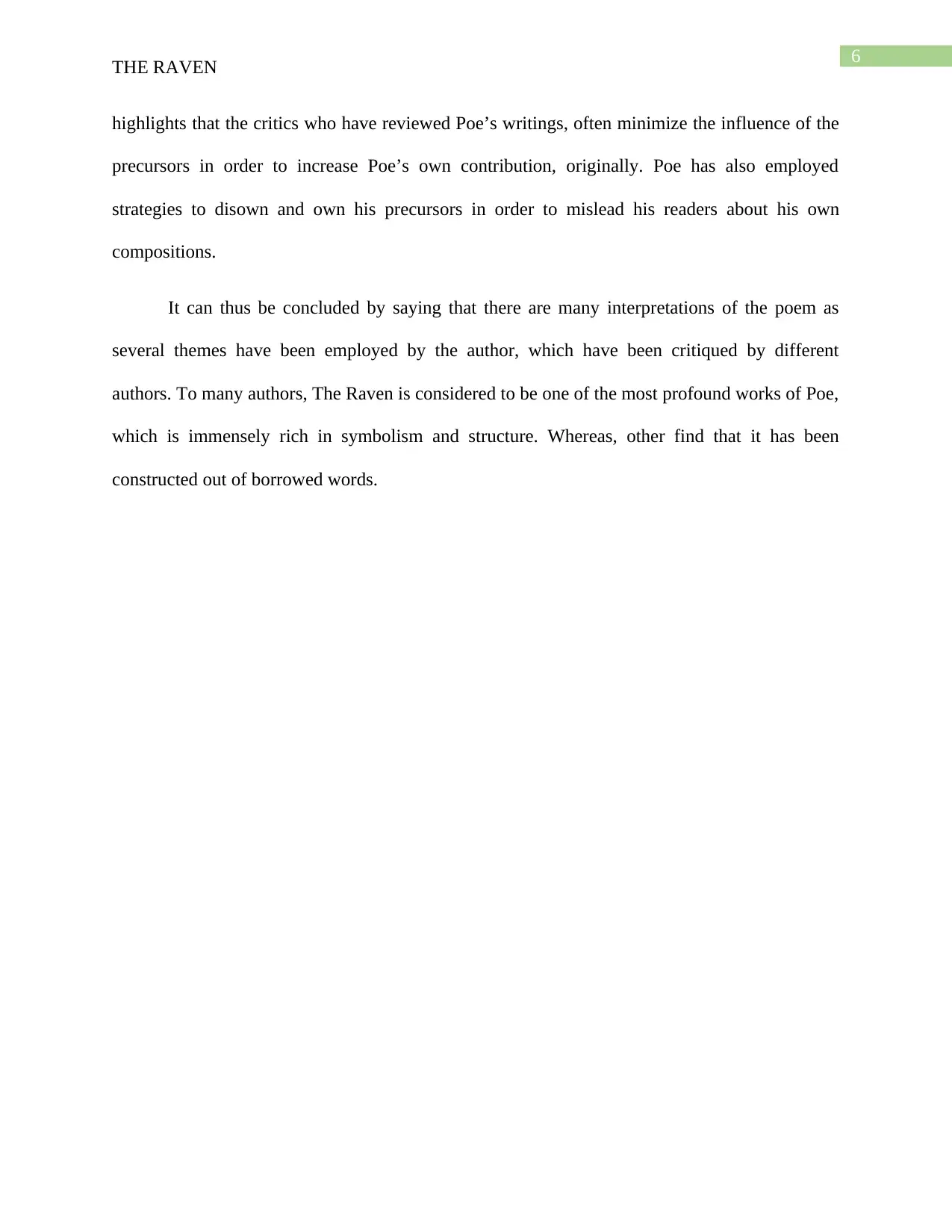
6
THE RAVEN
highlights that the critics who have reviewed Poe’s writings, often minimize the influence of the
precursors in order to increase Poe’s own contribution, originally. Poe has also employed
strategies to disown and own his precursors in order to mislead his readers about his own
compositions.
It can thus be concluded by saying that there are many interpretations of the poem as
several themes have been employed by the author, which have been critiqued by different
authors. To many authors, The Raven is considered to be one of the most profound works of Poe,
which is immensely rich in symbolism and structure. Whereas, other find that it has been
constructed out of borrowed words.
THE RAVEN
highlights that the critics who have reviewed Poe’s writings, often minimize the influence of the
precursors in order to increase Poe’s own contribution, originally. Poe has also employed
strategies to disown and own his precursors in order to mislead his readers about his own
compositions.
It can thus be concluded by saying that there are many interpretations of the poem as
several themes have been employed by the author, which have been critiqued by different
authors. To many authors, The Raven is considered to be one of the most profound works of Poe,
which is immensely rich in symbolism and structure. Whereas, other find that it has been
constructed out of borrowed words.
⊘ This is a preview!⊘
Do you want full access?
Subscribe today to unlock all pages.

Trusted by 1+ million students worldwide
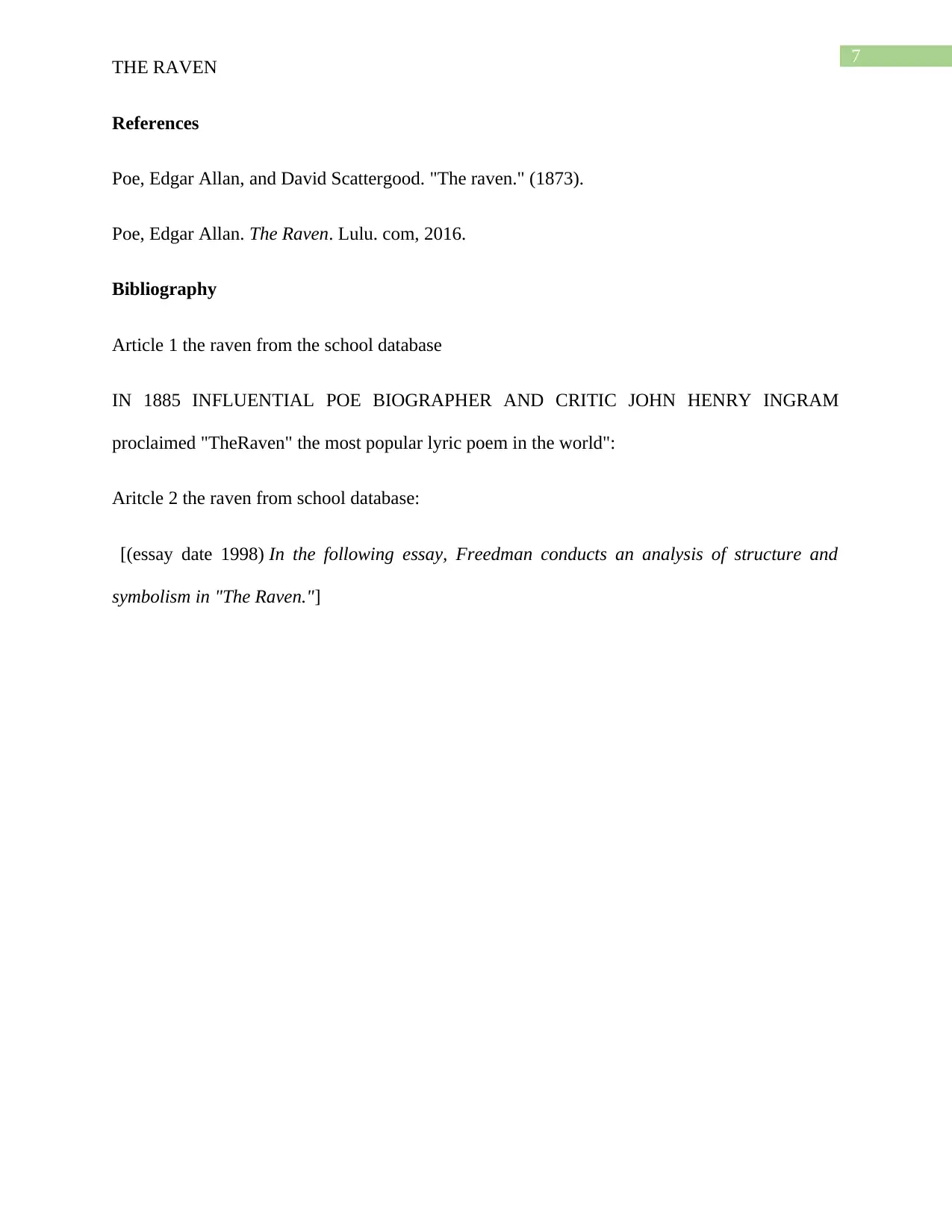
7
THE RAVEN
References
Poe, Edgar Allan, and David Scattergood. "The raven." (1873).
Poe, Edgar Allan. The Raven. Lulu. com, 2016.
Bibliography
Article 1 the raven from the school database
IN 1885 INFLUENTIAL POE BIOGRAPHER AND CRITIC JOHN HENRY INGRAM
proclaimed "TheRaven" the most popular lyric poem in the world":
Aritcle 2 the raven from school database:
[(essay date 1998) In the following essay, Freedman conducts an analysis of structure and
symbolism in "The Raven."]
THE RAVEN
References
Poe, Edgar Allan, and David Scattergood. "The raven." (1873).
Poe, Edgar Allan. The Raven. Lulu. com, 2016.
Bibliography
Article 1 the raven from the school database
IN 1885 INFLUENTIAL POE BIOGRAPHER AND CRITIC JOHN HENRY INGRAM
proclaimed "TheRaven" the most popular lyric poem in the world":
Aritcle 2 the raven from school database:
[(essay date 1998) In the following essay, Freedman conducts an analysis of structure and
symbolism in "The Raven."]
1 out of 7
Related Documents
Your All-in-One AI-Powered Toolkit for Academic Success.
+13062052269
info@desklib.com
Available 24*7 on WhatsApp / Email
![[object Object]](/_next/static/media/star-bottom.7253800d.svg)
Unlock your academic potential
Copyright © 2020–2025 A2Z Services. All Rights Reserved. Developed and managed by ZUCOL.





